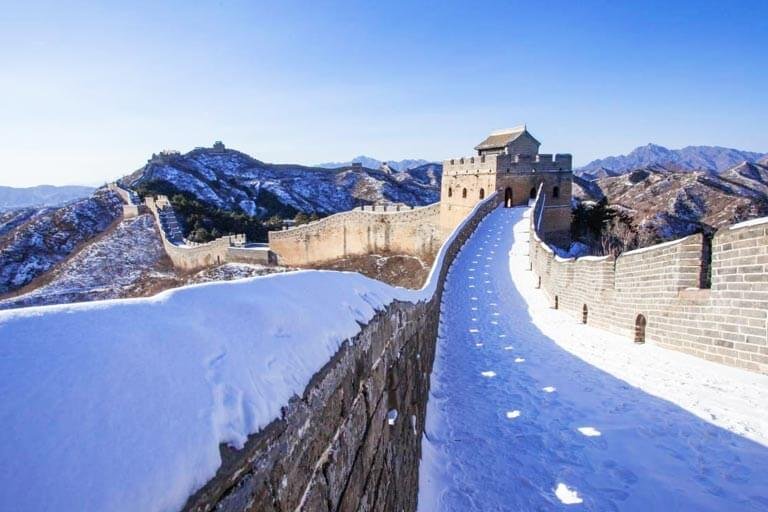The country of China is a very large one. It encompasses a total area of 9.597 million square kilometers, or 3.7 million square miles, and features a wide variety of landscapes and temperatures. In point of fact, China is the only country on the planet with the greatest range of climatic conditions.

Therefore, it is impossible to generalize about the climate in China because it varies greatly depending on where you are in the nation. But there’s no need to worry about that because we’ve simplified everything for you.
Northern China’s weather
Beijing and Harbin are two cities in northern China. A typical four-season climate may be found here.
Winter in Northern China
Northern China’s winters are bitterly cold and dry. During the winter, temperatures are often below freezing. The coldest month is January, with temperatures averaging -36°F (-38°C) in Harbin and 25°F (-4°C) in Beijing. Despite the fact that Northern China receives snow in the winter, it is normally a dry season. Each year, Beijing receives fewer than 2 inches of snow. Winters may be windy, with the wind coming down from Siberia, so layers, down coats, and thermals are essential.
Weather in Western China
Tibet, as well as places like Xinjiang, are located in western China. Summer and winter temperatures are recognized to be the most intense in the world. This is owing to the high height and rugged topography of the area.
Winters in Western China
Western China’s winters may be very cold. Tibet, for example, has been closed to international visitors for up to two months due to the extreme cold. Low-elevation areas, such as Xinjiang, will see temperatures as low as 3°F (-16°C). Heavy snowfall and severe white-out situations are also common in several areas of Western China. Western China’s winter is harshest from December to March, but it can continue from October to May in some areas.
Where exactly in China does it snow?
In general, snow occurs throughout a large portion of Northern China, with Harbin, Beijing, and Tianjin each seeing sleet and snow flurries throughout the colder months. In point of fact, it may seem much colder in central areas and cities like Wuhan and Changsha, because the humidity is high there and buildings are not as well suited for the colder weather as they are in other parts of the country.
Snowfall in Beijing
Over 21 million people make up the population of China’s capital city, making it the most populated in the world. Many of these people look forward to the city’s occasional dusting of snow, which fall between the months of November and March.
Even though January temperatures can be as low as 17.6 degrees Fahrenheit (-8 degrees Celsius), the colder weather does nothing to bring forth additional snow. Even at the height of winter, the overall monthly figure for snowfall is just approximately 0.07 inches (2 millimeters). In comparison, Beijing experiences rain on an annual basis equivalent to an average of 70 days and can get up to 22.5 inches (571.8 millimeters) of precipitation.
Snowfall in Harbin
The city of Harbin is often to as the “Ice City” in common parlance, and for good cause. The northeastern hub has longer winters that are bitterly cold and shorter summers that are noticeably colder than the rest of China.
In the month of January, temperatures can fall to as low as -11.2 degrees Celsius (-24 degrees Fahrenheit), and there is a good likelihood that snow will pile on the ground despite the fact that there is little chance that it will melt.
Snow falling at Zhong Guo Xue Xiang
Zhong Guo Xue Xiang is the most popular snow town in China. It is also known as Shuangfeng Forest Farm or simply “Home of Snow.” The little settlement, which is located 174 miles (284 kilometers) from Harbin, may experience snow accumulations of 78 inches (2000 millimeters) when winds sweep the snow into heaps surrounding the town.
It is important to note out that although Zhong Guo Xue Xiang is a gorgeous snowy wonderland, it is very much the exception, and the majority of China does not see snowfall on this level at any time throughout the year. This is something that should be kept in mind.
Learn About Places To Visit In China
Frequently Asked Questions About Winters In China
Does it snow in China on a regular basis?
In general, snow occurs throughout a large portion of Northern China, with Harbin, Beijing, and Tianjin each seeing sleet and snow flurries throughout the colder months.
Does it snow in China during the winter?
During the winter in northeast China, these domes of cold air that are sinking often prevent precipitation from the Pacific from reaching that region. As a direct consequence of this, Beijing receives only 2 percent of its annual average precipitation during this time period, which amounts to a meager 0.40 inches. Snow makes up the vast majority of that total amount.
How frigid can the weather get in China?
Temperatures in the northeast can drop to as low as -20 degrees Celsius (-4 degrees Fahrenheit) during the long, severe winters. The region’s summers are often quite warm and dry. The north and the central region has practically constant rains, summers that may be as warm as 26 degrees Celsius (79 degrees Fahrenheit), and winters that can go as cold as 0 degrees Celsius.